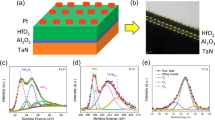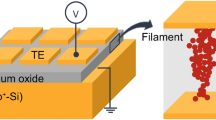Abstract
In order to better understand the memristive characteristics of Ag/1%(Co, Li)-co-doped ZnO/Pt/Si–SiO2 devices, this work looks at possible uses of dual-doped materials-based memory for neuromorphic computing. Transmission electron microscopy (TEM) was used to study the device structure after a 70-nm thin layer of 1% (Co, Li)-co-doped ZnO was formed on a Si–SiO2 substrate using a sputtering technique. The set and reset voltages of 1.22 V and 1.01 V, respectively, were demonstrated by the devices, which demonstrated dependable repeatable resistance switching for 80 cycles. Analyzing conductance modulation with recurrent both positive and negative pulses revealed depression and potentiation curves that were almost linear. In order to clarify the switching process, a physical model was put out that focused on the oxidation–reduction reactions that drive the production and rupture of Ag conductive filaments in the presence of an applied electric field. The device’s usefulness for neuromorphic computing systems is highlighted by its reversible transitions between high and low resistance states and its steady and symmetric I–V properties. These results imply that (Co, Li)-co-doped ZnO memristors are good options for creating dependable and effective memory technologies.







Similar content being viewed by others
References
S. Saleh, B. Koldehofe, On memristors for enabling energy efficient and enhanced cognitive network functions. IEEE Access 10, 129279–129312 (2022)
G. Atwood, Future directions and challenges for ETox flash memory scaling. IEEE Trans. Device Mater. Reliab. 4(3), 301–305 (2004)
D.B. Strukov et al., The missing memristor found. Nature 453(7191), 80–83 (2008)
A. Chen, A review of emerging non-volatile memory (NVM) technologies and applications. Solid-State Electron. 125, 25–38 (2016)
C.-C. Shih et al., Ultra-low switching voltage induced by inserting SiO 2 layer in indium–tin–oxide-based resistance random access memory. IEEE Electron Device Lett. 37(10), 1276–1279 (2016)
Y.-S. Fan, P.-T. Liu, C.-H. Hsu, Investigation on amorphous InGaZnO based resistive switching memory with low-power, high-speed, high reliability. Thin Solid Films 549, 54–58 (2013)
M. Zackriya, H.M. Kittur, A. Chin, A novel read scheme for large size one-resistor resistive random access memory array. Sci. Rep. 7(1), 42375 (2017)
X. Song et al., Effects of pyrazine derivatives and substituted positions on the photoelectric properties and electromemory performance of D-A–D series compounds. Materials 11(10), 2063 (2018)
A. Hao et al., Ce-doping induced enhancement of resistive switching performance of Pt/NiFe2O4/Pt memory devices. Ceram. Int. 43, S481–S487 (2017)
A. Goossens, A. Das, T. Banerjee, Electric field driven memristive behavior at the Schottky interface of Nb-doped SrTiO3. J. Appl. Phys. 124(15), 152102 (2018)
J. Guo et al., Enhanced magnetic modulation in HfO2-based resistive memory with an Hf top electrode. Appl. Phys. Lett. (2018). https://doi.org/10.1063/1.5038840
J. Jang et al., Highly improved switching properties in flexible aluminum oxide resistive memories based on a multilayer device structure. Adv. Electron. Mater. 4(12), 1800355 (2018)
N. Elboughdiri et al., Enhanced electrical and magnetic properties of (Co, Yb) co-doped ZnO memristor for neuromorphic computing. RSC Adv. 13(51), 35993–36008 (2023)
X. Yan et al., Memristor with Ag-cluster-doped TiO2 films as artificial synapse for neuroinspired computing. Adv. Func. Mater. 28(1), 1705320 (2018)
S. Porro et al., A multi-level memristor based on atomic layer deposition of iron oxide. Nanotechnology 29(49), 495201 (2018)
S.S. More et al., Resistive switching and synaptic properties modifications in gallium-doped zinc oxide memristive devices. Res. Phys. 12, 1946–1955 (2019)
F. Miao et al., Anatomy of a nanoscale conduction channel reveals the mechanism of a high-performance memristor. Adv. Mater. 23(47), 5633–5640 (2011)
R. Khan et al., The structural and dilute magnetic properties of (Co, Li) co-doped-ZnO semiconductor nanoparticles. MRS Commun. 12(2), 154–159 (2022)
U.B. Isyaku et al., ZnO based resistive random access memory device: a prospective multifunctional next-generation memory. IEEE Access 9, 105012–105047 (2021)
M.F. Hayat et al., Resistive switching properties in ferromagnetic co-doped ZnO thin films-based memristors for neuromorphic computing. J. Mater. Sci. Mater. Electron. 35(16), 1052 (2024)
R. Khan et al., Threshold switching in nickel-doped zinc oxide based memristor for artificial sensory applications. Nanoscale 15(4), 1900–1913 (2023)
R. Khan et al., Resistive switching properties in memristors for optoelectronic synaptic memristors: deposition techniques, key performance parameters, and applications. ACS Appl. Electron. Mater. 6(1), 73–119 (2023)
M. Laurenti et al., Zinc oxide thin films for memristive devices: a review. Crit. Rev. Solid State Mater. Sci. 42(2), 153–172 (2017)
X. Li et al., Realization of resistive switching and magnetoresistance in ZnO/ZnO-Co composite materials. Sci. Rep. 6(1), 31934 (2016)
T. Farooq, S. Mukaherjee, Study of resistive switching in titanium dioxide (TiO2) thin film for the application of non-volatile memory: a review. Int. J. Res. Appl. Sci. Eng. Technol. 7, 3030–3037 (2019)
A. Younis, S. Li, Microscopic investigations of switching phenomenon in memristive systems: a mini review. RSC Adv. 8(50), 28763–28774 (2018)
D.L. Xu et al., Bipolar resistive switching behaviors in Cr-doped ZnO films. Microelectron. Eng. 116, 22–25 (2014)
W. Xue et al., Intrinsic and interfacial effect of electrode metals on the resistive switching behaviors of zinc oxide films. Nanotechnology 25(42), 425204 (2014)
C.-L. Chen et al., Runx1 determines nociceptive sensory neuron phenotype and is required for thermal and neuropathic pain. Neuron 49(3), 365–377 (2006)
R.E. Brown, T.W. Bligh, J.F. Garden, The Hebb synapse before Hebb: theories of synaptic function in learning and memory before, with a discussion of the long-lost synaptic theory of William McDougall. Front. Behav. Neurosci. 15, 732195 (2021)
R. Vincent et al., Raman scattering in Me-doped ZnO nanorods (Me = Mn Co, Cu and Ni) prepared by thermal diffusion. Nanotechnology 19(47), 475702 (2008)
M. Masjedi-Arani, M. Salavati-Niasari, Metal (Mn Co, Ni and Cu) doped ZnO-Zn2SnO4-SnO2 nanocomposites: green sol–gel synthesis, characterization and photocatalytic activity. J. Mol. Liq. 248, 197–204 (2017)
J.A. Wibowo, N.F. Djaja, R. Saleh, Cu-and Ni-doping effect on structure and magnetic properties of Fe-doped ZnO nanoparticles. Adv. Mater. Phys. Chem. (2013). https://doi.org/10.4236/ampc.2013.31008
K. Rajwali, M.-H. Fang, Dielectric and magnetic properties of (Zn, Co) co-doped SnO2 nanoparticles. Chin. Phys. B 24(12), 127803 (2015)
J. Beltrán et al., Magnetic properties of Fe doped, Co doped, and Fe+ Co co-doped ZnO. J. Appl. Phys. (2013). https://doi.org/10.1063/1.4799778
N. Rajamanickam et al., Effect of (Li, Mn) co-doping on structural, optical and magnetic properties of chunk-shaped nano ZnO. J. Alloy. Compd. 614, 151–164 (2014)
Y. Yang et al., Observation of conducting filament growth in nanoscale resistive memories. Nat. Commun. 3(1), 732 (2012)
S. Chandrasekaran et al., The impact of TiW barrier layer thickness dependent transition from electro-chemical metallization memory to valence change memory in ZrO2-based resistive switching random access memory devices. Thin Solid Films 660, 777–781 (2018)
Y.-J. Huang et al., Dual-functional memory and threshold resistive switching based on the push-pull mechanism of oxygen ions. Sci. Rep. 6(1), 23945 (2016)
S.K. Pradhan et al., Resistive switching behavior of reduced graphene oxide memory cells for low power nonvolatile device application. Sci. Rep. 6(1), 1–9 (2016)
M.M. Rehman et al., Resistive switching in all-printed, flexible and hybrid MoS2-PVA nanocomposite based memristive device fabricated by reverse offset. Sci. Rep. 6(1), 36195 (2016)
T. Shi, R. Yang, X. Guo, Coexistence of analog and digital resistive switching in BiFeO3-based memristive devices. Solid State Ionics 296, 114–119 (2016)
M.S. Kadhim et al., A resistive switching memory device with a negative differential resistance at room temperature. Appl. Phys. Lett. (2018). https://doi.org/10.1063/1.5037191
F.M. Simanjuntak et al., Switching failure mechanism in zinc peroxide-based programmable metallization cell. Nanoscale Res. Lett. 13, 1–8 (2018)
Z. Wang et al., Engineering incremental resistive switching in TaO x based memristors for brain-inspired computing. Nanoscale 8(29), 14015–14022 (2016)
Q. Liu et al., Real-time observation on dynamic growth/dissolution of conductive filaments in oxide-electrolyte-based ReRAM. Adv. Mater. 24(14), 1844 (2012)
Y. Zhu et al., Enhanced stability of filament-type resistive switching by interface engineering. Sci. Rep. 7(1), 43664 (2017)
Acknowledgements
The authors extend their appreciation to Taif University, Saudi Arabia, for supporting this work through project number (TU-DSPP-2024-59).
Author information
Authors and Affiliations
Contributions
Naveed Ur Rehman, Aziz Ullah, Nasir Rahman, Ziaur Rehman, Mohammad Sohail, Shahid Iqbal, Khaled Althubeiti, Sattam Al Otaibi and Rajwali Khan: performed the experiment and wrote the original paper. Naveed Ur Rehman, Aziz Ullah, Nasir Rahman, Mohammad Sohail, Sattam Al Otaibi, and Rajwali Khan: discussed the results and implications. Khaled Althubeiti and Rajwali Khan: performed and analyzed the XRD spectrum. All authors commented on and approved the final version of the manuscript. Finally, Akif Safeen, Nizomiddin Juraev and Sattam Al Otaibi has successfully helped and guides us in comments addressing and removing grammatical errors.
Corresponding authors
Ethics declarations
Conflict of interest
The authors declare no interest conflict. They have no known competing financial interests or personal relationships that could have appeared to influence the work reported in this paper.
Additional information
Publisher's Note
Springer Nature remains neutral with regard to jurisdictional claims in published maps and institutional affiliations.
Rights and permissions
Springer Nature or its licensor (e.g. a society or other partner) holds exclusive rights to this article under a publishing agreement with the author(s) or other rightsholder(s); author self-archiving of the accepted manuscript version of this article is solely governed by the terms of such publishing agreement and applicable law.
About this article
Cite this article
Rehman, N.U., Khan, R., Rahman, N. et al. Dual-doped ZnO-based magnetic semiconductor resistive switching response for memristor-based technologies. J Mater Sci: Mater Electron 35, 1557 (2024). https://doi.org/10.1007/s10854-024-13318-5
Received:
Accepted:
Published:
DOI: https://doi.org/10.1007/s10854-024-13318-5




